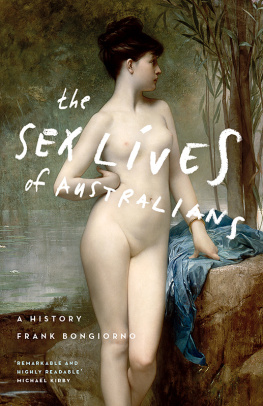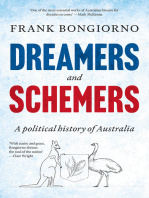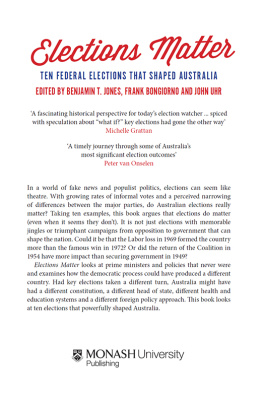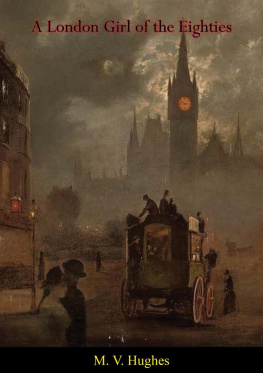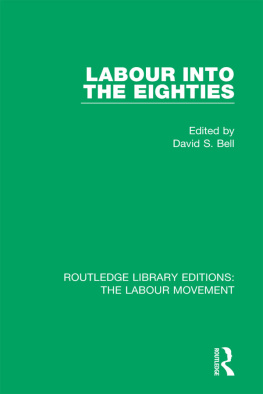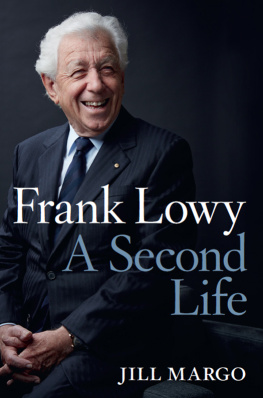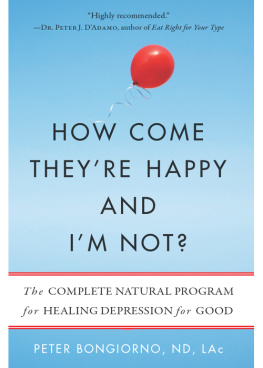Published by Black Inc.,
an imprint of Schwartz Publishing Pty Ltd
3739 Langridge Street
Collingwood VIC 3066 Australia
www.blackincbooks.com
Copyright Frank Bongiorno 2015
Frank Bongiorno asserts his right to be known as the author of this work.
ALL RIGHTS RESERVED.
No part of this publication may be reproduced, stored in a retrieval system, or transmitted in any form by any means electronic, mechanical, photocopying, recording or otherwise without the prior consent of the publishers.
National Library of Australia Cataloguing-in-Publication entry:
Bongiorno, Frank, 1969 author.
The eighties : the decade that transformed Australia / Frank Bongiorno.
9781863957762 (hardback)
9781925203592 (ebook)
Nineteen eighties.
AustraliaSocial life and customsHistory.
AustraliaPolitics and governmentHistory.
AustraliaHistory19761990.
994.06
Cover design by Peter Long
Cover image: Paul Mathews, Fairfax
Endpapers: Fairfax (front) and Alan Pryke, Newspix (back)
Text design by Tristan Main
Introduction
Stories of the 1980s
I t was the biggest party Australia had ever seen at least thats how its promoters touted it. In January 1988 the same month Australia would celebrate its Bicentenary Queenslands Gold Coast hosted the Ultimate Event. Paying visitors watched tennis and golf played by some of the worlds greats, laughed at the comedy acts and enjoyed the glamour of the fashion parades. Young Whitney Houston belted out a few numbers, and so did that renowned grandson of a Tenterfield saddler, Peter Allen, on a summer visit to the land he still called home. But the ultimate event of the Ultimate Event was the appearance of Frank Sinatra: 40,000 turned out to see the 72-year-old perform some old favourites through a river of his sweat, as the worlds most famous crooner battled the effects of his dinner jacket and bow tie, the stage lights and the subtropical humidity. Singing for an hour with the help of three teleprompters, Sinatra was said to have cleared $1.4 million for his efforts. It was a good night: even the rain which had been so unkind to the party previously, nearly wrecking the Whitney Houston concert, stopped for Ol Blue Eyes.
The occasion for the Ultimate Event was the opening of Sanctuary Cove, a residential, shopping, hotel and leisure development on the Gold Coasts Hope Island. It was a very eighties kind of place: expensive homes, big marina, golf courses, luxury hotel, boutiques and even its own local brew, served in a German-style beer hall.Coast businessmen who wielded considerable influence over the conservative state government.
In one of the early advertisements for Sanctuary Cove headed Are There 900 Civilised Human Beings in Queensland? Gore explained the concept behind his development. Surfers Paradise, with its ugly towers and miles of glitzy neon and greasy takeaways, was Paradise Lost. His 600 acres, however, were Paradise Regained:
Shellys Farm, Hope Island.
600 acres of salt marsh, leeches and scrub.
She was battered, and shed been raped, but I could see she was a lady.
I fell in love instantly, and within hours, she was mine.
Later I discovered her sad history. Shed been a fertile farm once.
But 30 years ago, the sand miners had moved in, dumped thousands of tonnes of silt in her natural harbour, destroyed the drainage, and formed the swamp.
I spent more than two million dollars on drainage.
I swore to restore the harbour.
I was hooked.
Gore thought of it as the place where we could make a new beginning, without the mistakes of the past, and claimed that development would complement the natural beauty of the place. Not compete with it or destroy it.
The sexual imagery of Gores promotional material was ripe, but his appeal to conservation was in tune with the times. Sanctuary Cove, however, also had a darker side, promoting itself as unashamedly elitist. It was, in effect, a gated residential community.
Gore would not stick around long to bathe in the glory of the Ultimate Event. He sold his share in Sanctuary Cove soon afterwards and later, in 1988, it was taken over by a Japanese company. He then experienced a series of business disasters and an expensive divorce, leaving for Canada with a new and much younger wife in 1992, owing his creditors a cool $25 million. Like several other entrepreneurs of the 1980s, the chain-smoking, hard-living Gore did not live long after his fall, dying of a heart attack in 1994 at just fifty-three.
Mike Gores is just one story of Australias eighties, but his career captures a striking number of its familiar elements: the optimism, the energy, the elitism (frequently combined with a pretend egalitarianism), the excess and the crash. Yet today such complexities are overlooked by many of us, who too frequently see the decade only through rose-tinted glasses. On FM radio and in television mini-series, it is the era of big hair and shoulder pads, synthesised pop and greed is good; of Michael Jackson, Madonna and Ronald Reagan; of British boy and girl bands, Live Aid for Ethiopia and Margaret Thatcher; of yuppies and masters of the universe as Tom Wolfe memorably called his New York stockbrokers in The Bonfire of the Vanities. It is the decade that began in the shadow of the bomb and ended in the joyful dismantling of the Berlin Wall. The worlds most famous political prisoner, Nelson Mandela, began the 1980s in much the same way he had lived for twenty years as a captive of a racist white regime in South Africa and ended it a free man, in time to assume his countrys presidency.
Australians participated in these happenings, sharing the excitements, challenges and surprises of the decade, and adding a few of their own. For us, it was the era of Hawke and Keating, of Neighbours and Crocodile Dundee, of let-it-rip capitalism and corporate excess, of assertive nationalism and cultural and sporting success. The decade has been treated as both an alpha and an omega. The journalist Paul Kelly famously claimed that the eighties saw the end of the Australian Settlement, the suite of ideas and policies that had underpinned the nation from the early twentieth century. White Australia, Industry Protection, Wage Arbitration, State Paternalism and Imperial Benevolence: all, said Kelly, were broken by the end of the 1980s and, he suggests, a jolly good thing, too.
In these accounts, the Hawke government is the gold standard for reformist governments of whatever stripe. Giants once strode the land: politicians who did not allow themselves to be diverted by last weeks focus group, this weeks opinion poll or todays 24-hour news cycle. Yet one of the leading participants in that government, Gareth Evans, recently commented that it did not always feel that way on the inside. Indeed, it is hard not to conclude that there is a certain forgetfulness operating when modern politicians, bureaucrats and journalists paint the 1980s as a political golden age. It is an aim of this book to provide an antidote to that amnesia.
The growing ascendancy of eighties youth in our own time might help to account for the decades rosy hue. We have had just one Generation X prime At the time of writing, six out of eight Australian premiers or chief ministers were, like Baird, born between 1968 and 1973. All probably know quite a few power ballads. Eighties youth are also coming into their own in business, education and culture.
The growing prominence of this generation would perhaps be sufficient justification for an account of the Australia that made them. But to tell the story of Australias eighties, it is not enough merely to evoke the experience of the young, the elite or the globally aware; there were other 1980s, too: those of the newly arrived migrant, the displaced manufacturing worker, the Aboriginal battler, the working mother, the nervous pensioner, the struggling or wealthy farmer, the disappointed radical, the disgruntled conservative. There was continuity as well as change, collectivism alongside individualism, the old and the durable hanging on alongside the new and disposable. A 1986 federal government inquiry into folklife concluded that white Australians were the heirs to living traditions games, rhymes, sayings, yarns, songs, dances, poems, customs, superstitions, recipes and skills that ran deep, giving each of us our own sense of cultural identity, yet binding us together as Australians. This folk culture, with its powerful sense of continuity and roots in the European past, would reveal its enduring strength during the Bicentenary of 1988, despite the glitzy overlay of celebrity song and corporate branding.



